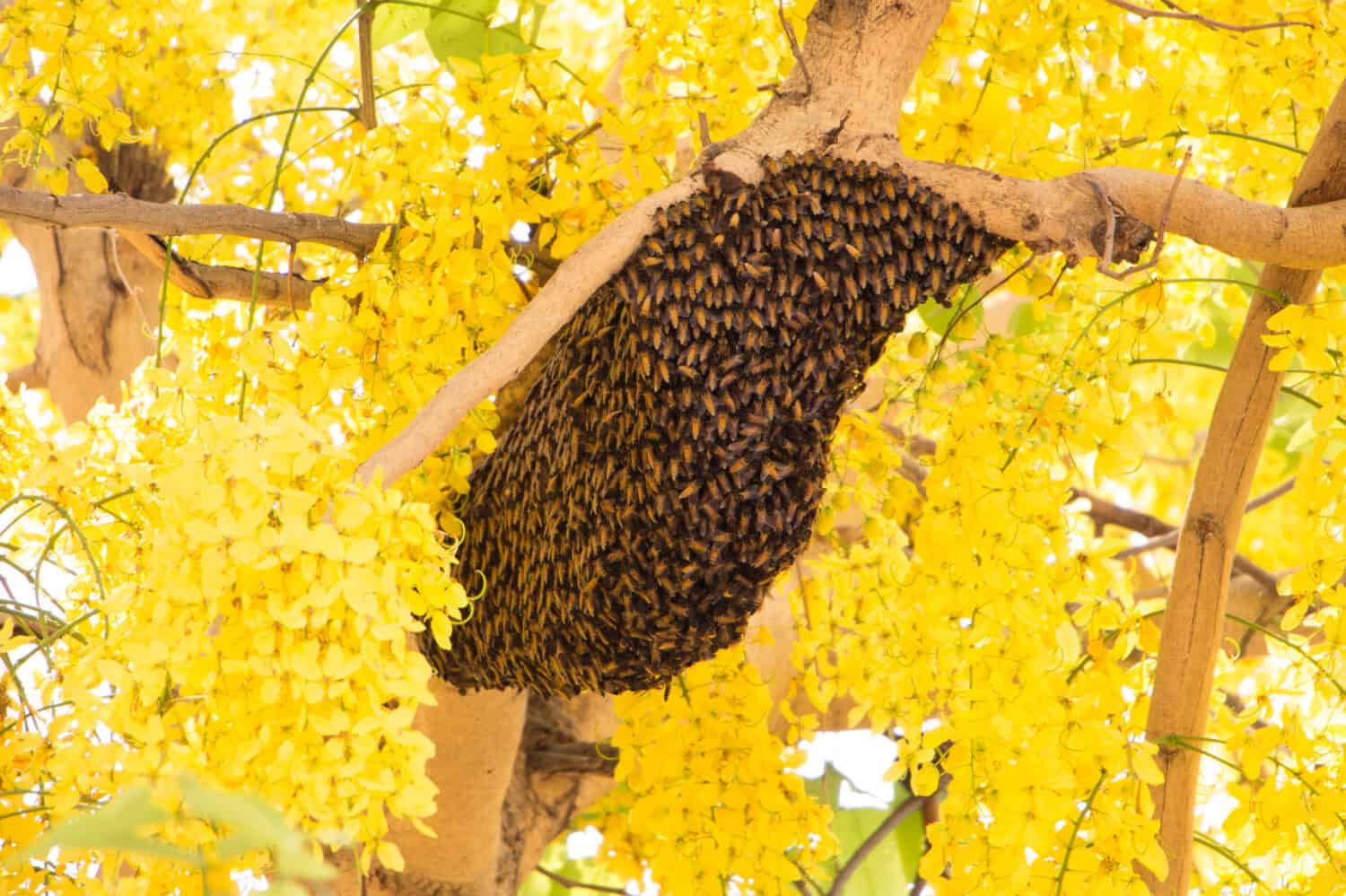It’s important that honey bees choose a suitable spot to build their nests. Generally, they build their hives in a hollow tree or small cave. Then, as the colony expands, the bees set out in search of a larger place to create a new home. But how do they find the perfect site? It involves a remarkable amount of complex communication and skillful teamwork, basically making the colony work as if it were a single organism. No one is left out of these tasks, and each individual has a role to play. Unfortunately, their lives are so short that they hardly ever see the fruits of their labor. Continue reading to learn about honey bee nests and how to identify them.
Location of Honey Bees Nests
Bees are creatures of habit and like to build their nests in very specific locations, which will vary depending on the species. For example, bumble bees prefer ground-based nests, while honey bees choose sites like hollow trees, caves, and rock crevices. However, sometimes they choose to build their hives in people’s homes or gardens, like inside a wall of a building or house. While most depictions of bee hives show them hanging off a branch of a tree, honey bees don’t like being so exposed. However, it is possible to see a large group congregating on a tree branch, but it’s not a nest; it’s a swarm. Honey bees swarm when they have outgrown their current hive and are busy scouting a new location to build a new one.

Typically, honey bees choose sites like hollow trees, caves, and rock crevices for nests. However, sometimes they choose to build their hives in gardens.
©Infinity_Pok/Shutterstock.com
How Do Honey Bees Make Their Nests?
Honey bees secrete wax from pores on the sides of their bodies to make their nests. Therefore, the hive contains thousands of hexagonal cells called combs. So, to create a sturdy building substance, the worker bee consumes honey, converting it to sugar inside their bodies. Next, the wax exits their bodies through pores on their abdomens. Finally, the worker bees chew the substance, mixing it with their saliva, making it pliable. So, each cell consists of tiny mouthfuls of wax, which they need to repeat hundreds of thousands of times as the colony expands. For example, most nests are made up of about 100,000 cells. And each layer serves a different purpose. The top combs house the honey, the middle combs store pollen, and the lower combs are the brood cells. This is where offspring are hatched and raised.
How to Get Rid of a Honey Bee Nest
There is no sound as ominous as swarming bees. So, it’s natural to be nervous when discovering a honey bee nest in your home or garden. But, if you apply the correct method and solicit professional help, there are ways of safely removing a swarm or hive.
Preventing a Colony of Honey Bees in Your Home
It might be hard to determine if a colony of honey bees on the side of a building is scouting for a new site or entering the building one by one through a small hole. However, keep an eye on them, and if you don’t see any flying away, but the colony is getting smaller, they are moving in. After moving into the building, the bees won’t have much food and must begin producing wax to build combs. Therefore, they need access to the outside to look for nectar.
However, if you seal them in their new home by covering the hole with steel wool, screen, or any material they can’t chew through; they won’t be able to survive. Unfortunately, it can take up to two weeks for them to die. Additionally, they will try to escape through other gaps, so it is possible you might encounter a few bees in your living space. But, they usually fly for the widows, where they stay until they die of dehydration.
But killing bees is not the answer. They are essential to life on earth and need to be preserved. Therefore, calling a beekeeper is the best solution. They have methods of removing the bees without killing them and safely relocating them.
Honey Bee Nest Removal
Removing a honey bee nest from your home is much more complicated than eliminating swarm clusters. But here are three methods:
Pesticides
While there are pesticides that will kill the whole colony, it comes with consequences. Firstly, as mentioned above, killing these bees is extremely detrimental to our well-being. Secondly, when bees fall and form a large pile, the moisture in their bodies will cause rot, which produces a terrible smell. In addition, the liquid formed from decomposing mass often infiltrates the structure, which costs a fortune to replace.
Hire a Beekeeper
A better solution is hiring a beekeeper to remove the honey bee nest without killing them. For example, the professional will be able to find the nest, usually by tapping on the wall until they hear the hum of the bees. In fact, some beekeepers use a stethoscope to accurately find the edges of the hive. However, there are other methods. Some professionals drill small holes into the wall and insert a fine wire to find the outer limits of the nest.
Furthermore, collecting these bees and their nest requires a relatively large hole in the wall. Therefore, you will also need to hire a contractor to ensure the hole is cut so it can be sealed easily. Next, the beekeeper will gently remove the bees and their combs. This is usually done with a vacuum that has a baffle or container which protects the bees. However, this process usually causes the bees to become defensive and release a scent that sounds the alarm. So, everyone in the home must wear a bee suit.
One-way Wire Screen
Another way to get rid of honey bees in your home is by trapping them outside with a one-way wire screen. While this technique requires a lot of patience, it doesn’t kill bees. Basically, this method works by luring the bees to a beehive placed across the original entrance and relocating the bees to a safe spot. Never try to remove a honey bee nest on your own, as it is extremely dangerous, especially if you are allergic.
Preventing Future Invasions
Removing the honey bees and their nest doesn’t solve the problem. The smell of beeswax lingers, and because these bees have such an amazing sense of smell, other colonies might find the site incredibly tempting. Furthermore, this odor sticks around long after the original colony is removed. Therefore, all gaps or holes larger than a pencil must be sealed. But you don’t need to seal larger entrances. Instead, you can cover them with a screen with six or more meshes per inch.
In addition, you can fill large cavities with expandable foam, which will deter the bees from building a nest as there won’t be enough space. It’s essential to examine and repair areas on the entire side of the building where the original entrance was or both sides if the entrance was on a corner. Ensure you are thorough because they’ll move in immediately if they find access.
But, it’s not just new colonies that will want to move in; some original colony members might have escaped. In addition, foragers sometimes spend the night away from the nest during warmer months. Therefore, there is a strong possibility a cluster of honey bees will congregate at the sealed-off entrance. You can vacuum these bees up or use a pesticide spray specifically for wasps and bees. However, ensure to read the instructions first.
The photo featured at the top of this post is © vivatchai/Shutterstock.com
Thank you for reading! Have some feedback for us? Contact the AZ Animals editorial team.





